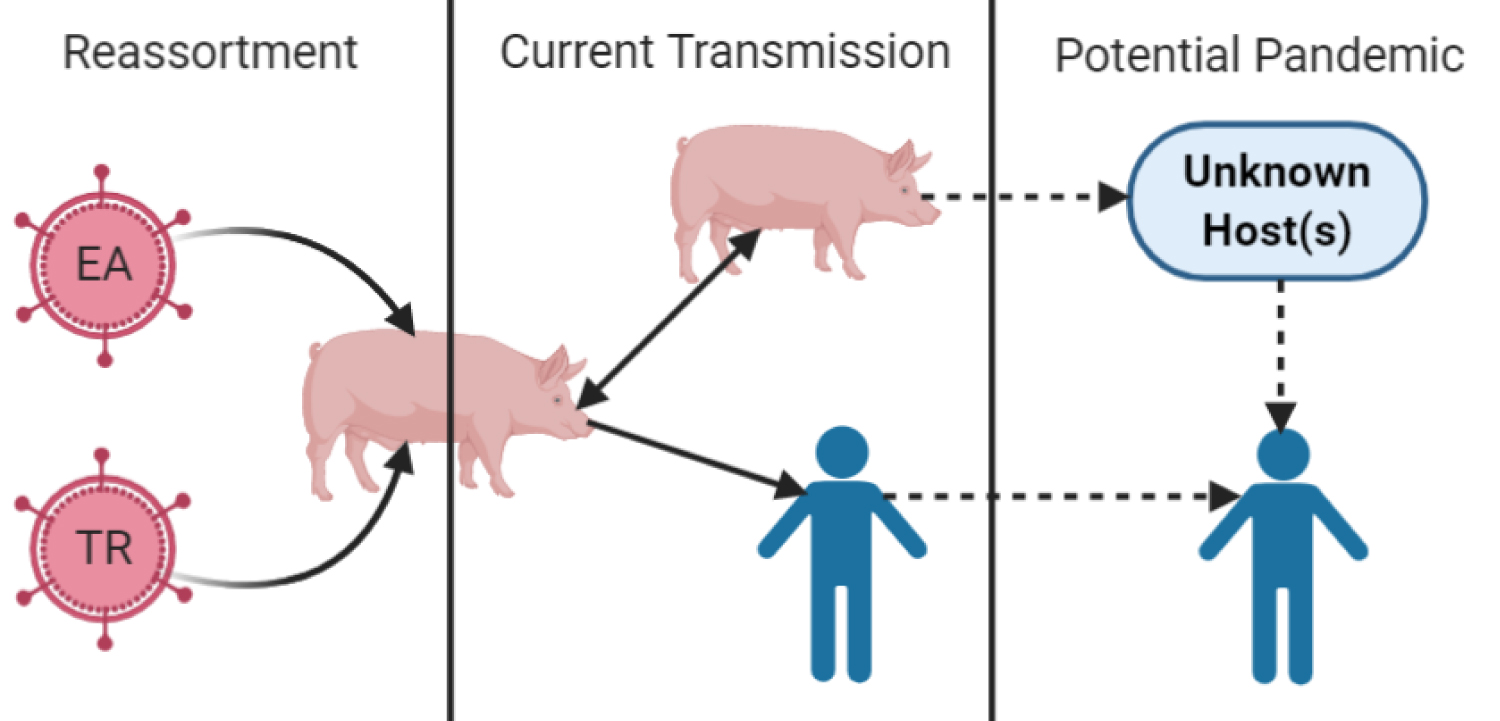The currently developing devastating pandemic of the coronavirus disease 2019 (COVID-19) has took over the global attention. Meanwhile, another virus with high potentiality to grow into a global pandemic has emerged in China, where human infections of the strain genotype 4 (G4) reassortant Eurasian avian-like (EA) H1N1 virus had been reported. However, fortunately human-to-human transmission was not detected yet but we need to keep an eye out for such potential scenario particularly that by the time we fully understand the virus transmission it might be too late to contain it and prevent a second global crisis. Health systems are collapsing under the current COVID-19 pandemic, nevertheless, we need to prepare for worst situation of having two pandemics side-by-side which would be a disastrous threatening the entire humanity. A better international commitment for collaboration, one health and early detection and response system need to be on place worldwide.
Genotype 4 Reassortant Eurasian Avian-Like H1N1 virus, G4 EA H1N1, Swine flu virus, Influenza A virus assortment
A highly infectious swine flu virus is currently emerging through China. The strain genotype 4 (G4) reassortant Eurasian avian-like (EA) H1N1 virus has the potential to cause a global pandemic. Expert identified pigs as the intermediate hosts for this strain of influenza virus; until now there is no evidence of human-to-human transmission, so we don't have another human epidemic yet [1]. Swine flu is a virus that replicates among pigs as the main host, while human normally not get infected by it, when they accidentally do, it's called "variant influenza virus", which is limited. Until now, 5 human cases of G4 EA H1N1 have been reported in china [2-6].
Pigs are susceptible to hosting, replicating, and spreading influenza A viruses from birds, humans, and other infected pigs [7]. This susceptibility means that pigs are the intermediate host which are designated as 'mixing vessels' that act as a host for development of influenza viruses. Influenza viruses sometimes interchange genes when two or more viruses spontaneously infect the same pig or similar host, which called reassortant (Figure 1) [1]. Sometimes this lead to a novel strain that can infect humans. The threat of reassortment of influenza viruses is to produce progeny viruses with novel antigenic features enabling it to escape from immune recognition but it could cost it to deceasing viral aggression which will require a novel vaccine [8]. The high similarity between the G4 viruses and the prototype candidate vaccine virus (CVV) developed by the World Health Organization (WHO) and the difference from the seasonal flu vaccine which makes both vaccines ineffective against the G4 viruses [1]. This creates an urgency need for the development of an effective vaccine against the G4 viruses.
 Figure 1: Genome segment assortment in influenza A viruses. The eight RNPs form a supramolecular complex that is encapsidated by a lipid-based envelope through budding to make the virion.
View Figure 1
Figure 1: Genome segment assortment in influenza A viruses. The eight RNPs form a supramolecular complex that is encapsidated by a lipid-based envelope through budding to make the virion.
View Figure 1
Recent human infections among abattoirs workers had been identified in surveillance study, among 300 workers on 15 pigs-farms have revealed 10.4% seroprevalence G4 EA H1N1 antibodies. Therefore, G4 EA H1N1 had been identified as the new viral genome of swine flu. The virus genome had been characterized and Genotype 4 (G4) had been identified as the dominant [1]. However, the G4 viruses are capable of binding to human-like SAα2, 6Gal receptors and to replicate in the human airway epithelial cells [1]. Furthermore, animal model revealed that the virus infection could be airborne increasing its infectivity significantly [1]. Moreover, scientific evidence strongly suggests if human-to-human transmission occurs, we would be facing another large pandemic (Figure 2). Therefore, a systematic one health surveillance of influenza virus in pigs and closely related animals is crucial to prevent a pandemic.
 Figure 2: Diagram shows the development G4 EA H1N1 reassortant, the currently known transmission cycle, and the potential scenario for pandemic of G4 viruses.
Figure 2: Diagram shows the development G4 EA H1N1 reassortant, the currently known transmission cycle, and the potential scenario for pandemic of G4 viruses.
EA : Eurasian avian-like (EA) H1N1 virus 2009 pandemic strain; TR: Triple Reassortants swine virus. Solid arrows show the direction of currently known transmission and the dotted arrows explain the direction of potential transmission scenarios.
View Figure 2
Currently, health systems worldwide are challenged by the COVID-19 pandemic and struggling to contain it, the risk of a second health emergency of global concern is dire, particularly in resources-limited in most developed countries where the health system is fragile and the basic molecular diagnostic tools needed to identify viral infections are lacked in most of the country [9]. Another major challenge for a successful prevention and control strategy is the common delay in sharing the relevant data and information on a timely basis, this needs to be changed and global commitment for the immediate and public sharing of health informatics should be enforced [10].
In conclusion, we emphasized the importance of controlling the spread of G4 EA H1N1 virus in pigs. Furthermore, close monitoring of human population that located near and/or in direct contact with pigs farms and products, and most importantly a global collaborations with focus on the transparency and timely sharing of the related data is essential for a successful containment strategy. Additionally, one health surveillance with early detection and response is crucial for the prevention and control of emerging viral diseases.
This research did not receive any specific grant from funding agencies in the public, commercial, or not-for-profit sectors.